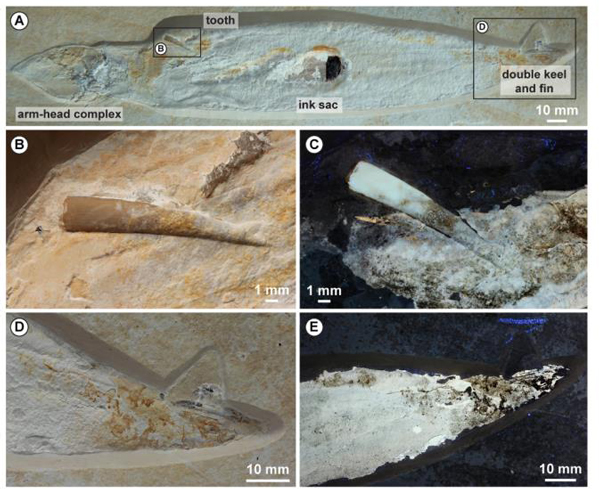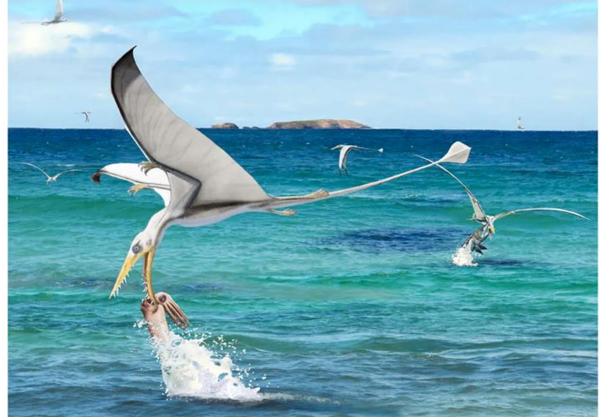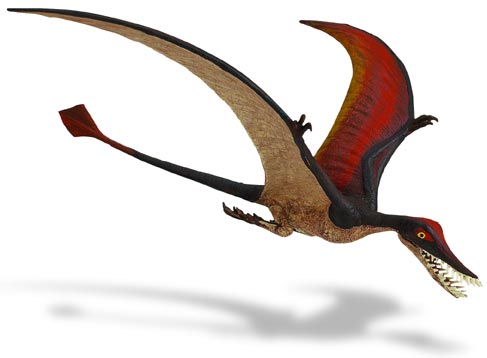New Research Suggests Rhamphorhynchus Fed on Squid
Pterosaur Tooth Discovered in Jurassic Squid Fossil
The pterosaur Rhamphorhynchus, probably fed by grabbing soft-bodied creatures such as squid as it flew close to the surface of the sea. That is the conclusion made by a group of researchers reporting on the remarkable fossil of a squid-like animal with a pterosaur tooth embedded in its body found in Germany. Writing in the academic journal Scientific Reports, the authors of the paper, describe the beautifully preserved remains of the octobrachian (eight-armed) cephalopod Plesioteuthis subovata which has a pterosaur tooth embedded in its left flank.
Reconstruction of the Hunting Behaviour of Rhamphorhynchus muensteri
Picture credit: C. Klug and Beat Scheffold
Discovered in 2012
The cephalopod fossil was found in 2012 and it heralds from the world-renowned Solnhofen Lagerstätte in south-eastern Germany. The strata from which the remarkable specimen was gathered has been dated to the Upper Jurassic Altmühltal Formation (lower Tithonian faunal stage – ammonite Hybonoticeras hybonotum biozone). The fossil is kept at the Paläontologisches Institut und Museum, Universität Zürich, Switzerland (PIMUZ 37358).
Views of the Plesioteuthis subovata Specimen Showing the Pterosaur Tooth

Picture credit: R. Hoffmann et al (Scientific Reports)
The picture above shows (A), the 28 cm long fossil of the coleoid Plesioteuthis subovata with highlighted areas (B and D). The pterosaur tooth measures 19 mm long and picture (C) shows the tooth viewed under ultraviolet (UV) light. The tip of the tooth is partially covered with phosphatised mantle tissue, thus ruling out the association of the tooth during the fossilisation process. Insert (D), shows the posterior portion of the mantle with faint imprints probably representing a terminal fin. Under UV light analysis no evidence of fin musculature could be identified (E).
Direct Evidence of Hunting/Feeding Behaviour
Such direct evidence of hunting/feeding behaviour is rarely preserved in the fossil record. The authors of the scientific paper, which include a researcher from the University of Leicester (UK), suggest that the adult Plesioteuthis subovata was swimming close to the surface when a pterosaur (suspected of being Rhamphorhynchus muensteri), made a grab for it. It is not known whether the injury sustained to the squid proved fatal, or whether the animal lived for a period of time before finally dying and becoming preserved in the fine-grained sediments associated with the Solnhofen Archipelago.
The tooth most likely came from the front or middle regions of either the upper or lower jaw. As rhamphorhynchid teeth associated with very young or juveniles tend to be much smaller and straighter, the researchers conclude that the tooth came from a mature adult pterosaur with a wingspan of at least one metre.
A Model of Rhamphorhynchus (Wild Safari Prehistoric World)
Picture credit: Everything Dinosaur
The image (above) shows a Rhamphorhynchus model from Safari Ltd.
To view this model range: Wild Safari Prehistoric World.
Pterosaur Tooth Helps to Construct Ancient Food Webs
The coleoid/pterosaur fossil will help scientists to better understand the palaeo-ecosystem associated with the Solnhofen Lagerstätte. Whilst it is true that many different types of predator may have fed upon Plesioteuthis subovata, the size, shape and the lack of longitudinal ridges discounts marine reptiles such as ichthyosaurs, pliosaurs and crocodyliformes. The tooth coming from a type of predatory fish has also been discounted.
The single tooth is most likely from a mature Rhamphorhynchus in a failed hunting attempt. This seems to be the most plausible interpretation of the fossil evidence. Furthermore, several Rhamphorhynchus fossils are known where the pterosaur is entangled within the jaws of the predatory fish Aspidorhynchus. It has been assumed that these types of fish hunted close to the water surface and would have grabbed pterosaurs as they swooped to feed. These fossils indirectly corroborate the suggestion that this pterosaur-cephalopod interaction occurred near the water surface.
Sometimes the Hunter Became the Hunted (Rhamphorhynchus Entangled with the Jaws of Fish)

Picture credit: PLOS One
Skim-feeding had been proposed for marine pterosaurs such as Rhamphorhynchus but subsequent studies suggested that this was too energy expensive. It is more likely that Rhamphorhynchus captured prey on the wing just above the water surface or while floating on the water surface.
The scientific paper: “Pterosaurs ate soft-bodied cephalopods (Coleoidea)” by R. Hoffmann, J. Bestwick, G. Berndt, R. Berndt, D. Fuchs and C. Klug published in Scientific Reports.
The Everything Dinosaur website: Everything Dinosaur.



